Top ultrawide monitors for games, work, video editing.
Ultrawide monitors have appeared on the market just recently. They were created to compete with standard two or three monitor setup in order to improve your experience when working on a desktop computer.
With a wider screen, you can fully plunge into the virtual world and increase your productivity. The reason for such an enhancement is additional space which optimizes your workflow and reduces the time spent on the process.
The main distinction of an ultrawide monitor is, of course, its size. With the aspect ratio of 21:9 (which is actually 64:27), it creates a big difference compared with the standard 16:9 ratio. On such a screen, you can place more applications, programs, videos, browsers, documents, and everything else that you need to have on your desktop simultaneously.
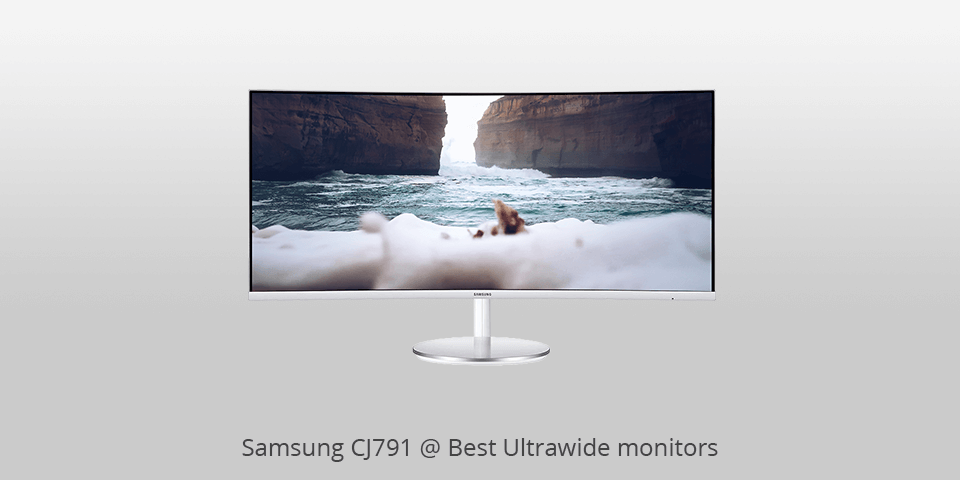
Screen size: 34-inch | Aspect ratio: 21:9 | Resolution: 3440x1440 | Brightness: 300 cd/m2 | Refresh rate: 100 Hz | Response time: 4 ms | Viewing angle: 178/178 | Contrast ratio: 3000:1 | Color support: 125% sRGB
⊕ Precise colors
⊕ An ergonomic stand
⊕ FreeSync support
⊖ Quite weak contrast
⊖ Can show an image from two inputs
Samsung CJ791 can be the best ultrawide monitor for you as it provides amazing quality of image, deep blacks, prominent, natural and saturated colors that come from all angles. Due to the 100Hz refresh rate and AMD’s FreeSync, this monitor provides great video quality.
This monitor has a matte, anti-reflection coating, which means that you don’t need to worry about having to place it in a particular way in a glare-prone environment. Aside from the display, Samsung CJ791 has another important feature – two Thunderbolt 3 ports transmitting display, 40Gb of data, and 58W power all in one cable.
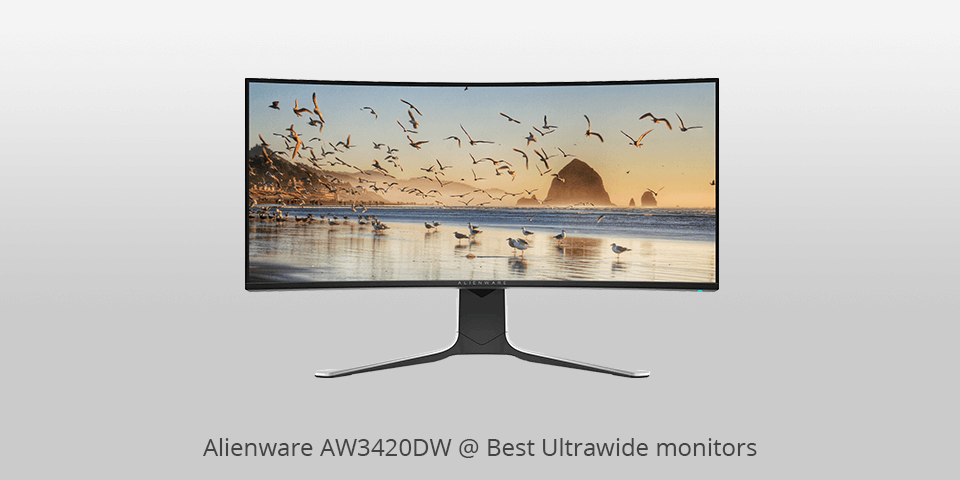
Screen size: 34.1-inch | Aspect ratio: 21:9 | Resolution: 3440 x 1440 | Brightness: 350 cd/m2 | Refresh rate: 120 Hz | Response time: 2 ms | Viewing angle: 178/178 | Contrast ratio: 1000:1 | Color support: 134.5% sRGB
⊕ Fast to respond
⊕ Nice design
⊕ High quality image
⊖ More ports are required
Dell’s 34-inch Alienware ultrawide monitor is a great option for those who like playing a lot. It offers a resolution of 3.440 x 1.440 and a curved IPS panel (1900R), providing deep colors and wide viewing angles. This monitor also has a 350-nit brightness maximum and a contrast ratio of 1.000:1.
In addition, Alienware AW3420DW provides a 2ms grey to grey response time with Overdrive and the 120Hz refresh rate. This guarantees fast response while gaming and lets you experience every action and movement of the game.
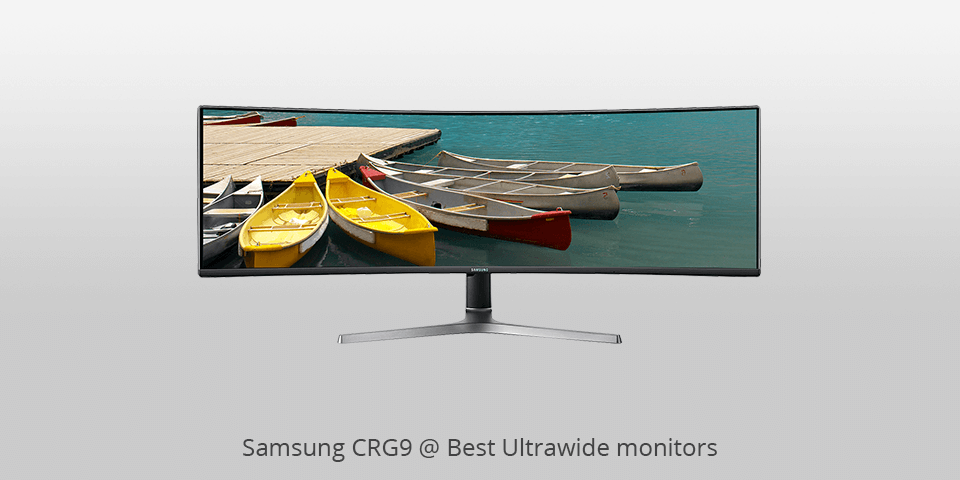
Screen size: 49-inch | Aspect ratio: 32:9 | Resolution: 5120 x 1440 | Brightness: 600 cd/m2 | Refresh rate: 120 Hz | Response time: 4 ms | Viewing angle: 178 / 178 | Contrast ratio: 3000:1 | Color support: 125% sRGB
⊕ Great peak brightness
⊕ HDR 1000
⊕ Nice screen
⊕ Offers a quantum dot technology
⊖ Expensive
⊖ Limited ergonomics
Samsung CRG9 is a big-sized monitor and it’s pretty big for a larger than a standard desk. If you are thinking of buying this monitor for gaming at home, you will have to measure it and your desk space first. This ultra wide gaming monitor is 47 inches (1,198mm) wide, which is almost 4 ft.
It has a nice Picture-by-Picture mode. When it’s on, you will be able to use two inputs that will create a dual monitor display without a border between them. In this way, you will be able to game on one side of the screen and have another application or document opened on the second one.
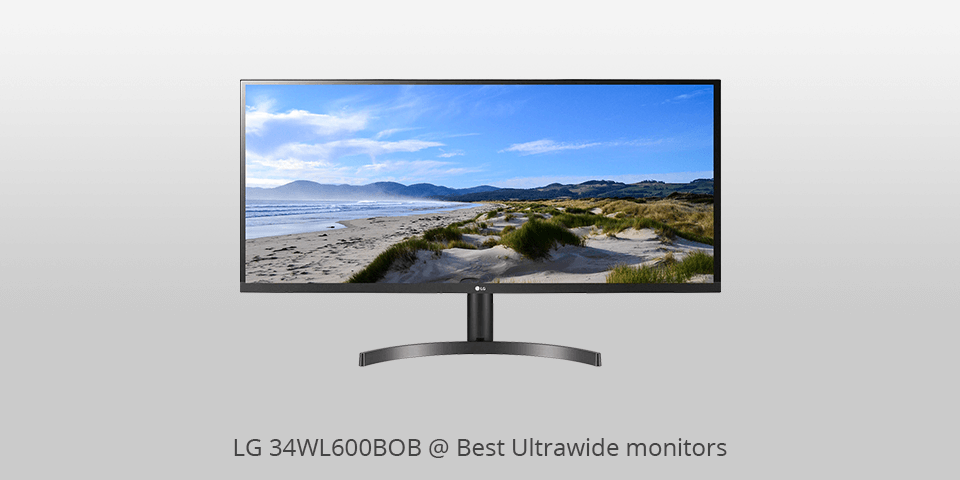
Screen size: 34-inch | Aspect ratio: 21:9 | Resolution: 2560 x 1080 | Brightness: 250 cd/m2 | Refresh rate: 75 Hz | Response time: 5 ms | Viewing angle: 178/178 | Contrast ratio: 1000:1 | Color support: 99% sRGB
⊕ Not expensive
⊕ FreeSync technology
⊖ Has a low refresh rate
This ultra wide monitor has thin glasses on three sides and is compatible with bright and clear images. Due to MaxxAudio, you will be able to achieve good results. In just several mouse clicks, you will be able to manage basic screen settings for images and sounds fast and easily, and divide the screen into two parts.
With FreeSync, gamers will have smooth sound movements in high-resolution and fast games. FreeSync removes practically all screen tears and paper jams. With 99% of sRGB coverage, LG 34WL600BOB is a great option for photographers, graphic designers, or those who want a monitor with high-precision colors.
Dynamic Sync provides faster response speed in RTS games, which reduces input lag and creates better performance.
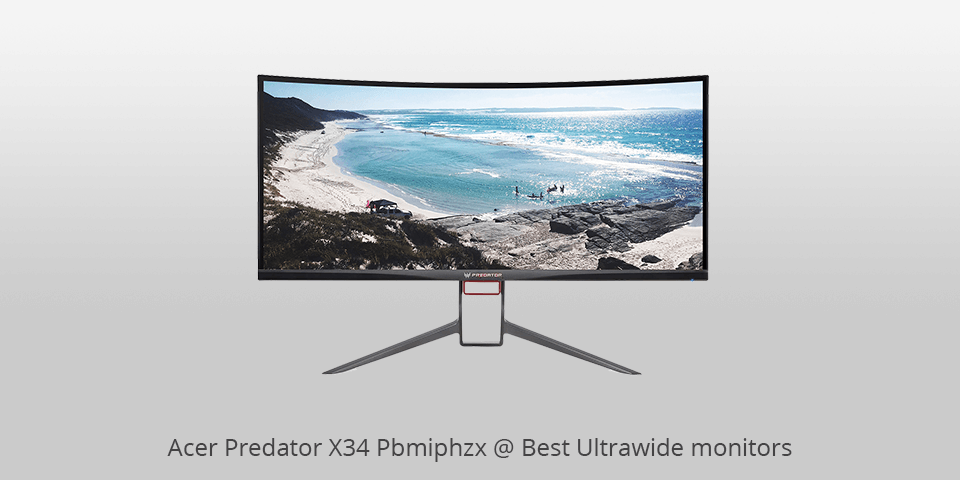
Screen size: 34-inch | Aspect ratio: 16:9 | Resolution: 3440 x 1440 | Brightness: 300 cd/m2 | Refresh rate: 100 Hz | Response time: 4 ms | Viewing angle: 178/178 | Contrast ratio: 1000:1 | Color support: 100% sRGB
⊕ Precise gamma and color after calibration
⊕ Low waiting period
⊕ Ergonomic design
⊕ RGB lighting
⊖ Some units might have particularly pronounced scanlines
It has a large cabinet with a size of 14.8 by 32.2 by 4 inches (HWD). This monitor doesn’t have frames and is covered with a glossy black finish. It has a chevron-shaped pattern on the back and a Predator sign in the frontal part.
Its 34-inch panel uses the In-Plane Switching (IPS) technology and can boast a 3.440-by-1.440 resolution and an aspect ratio of 21:9. This is one of the best ultrawide monitor models as it also offers such features as an on-screen frame-rate counter and Dark Boost that lets you lighten colors in the game without ruining the whole picture.

Screen size: 34-inch | Aspect ratio: 21:9 | Resolution: 3440x1440 | Brightness: 300 cd/m2 | Refresh rate: 144 Hz | Response time: 1 ms | Viewing angle: 178/178 | Contrast ratio: 3,000:1 | Color support: 115% sRGB
⊕ Great performance
⊕ Dial Point feature
⊕ AMD FreeSync technology
⊖ Doesn’t offer the G-Sync technology
This widescreen monitor has no frames and is very robust. It focuses on top-quality performance rather than promoting its gaming design through sharp angles and bright RGB lighting. However, if you want the best monitor for FSP gaming, you will be impressed by a 144Hz refresh rate, 1ms response time, and 1440p resolution for the effect of full emersion into the game.
This monitor offers great ergonomic customization features. You can adjust the height, swivel and tilt. In addition, it has two HDMI 2.0 and two DisplayPort 1.2 outputs. There are also a four-port USB 3.0 hub and analog audio output. However, the monitor has no embedded speakers.
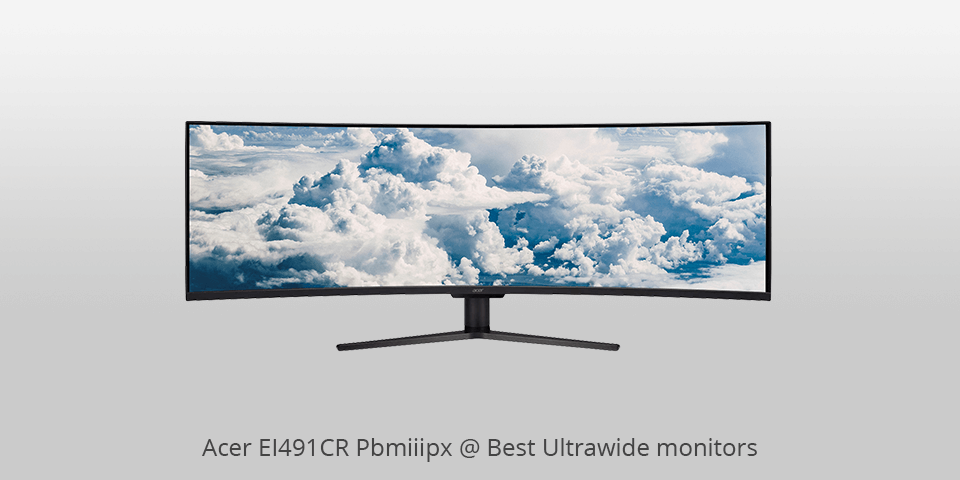
Screen size: 49-inch | Aspect ratio: 32:9 | Resolution: 3840 x 1080 | Brightness: 400 cd/m2 | Refresh rate: 144 Hz | Response time: 4 ms | Viewing angle: 178/ 178| Contrast ratio: 3000:1 | Color support: 130.7% sRGB
⊕ AMD FreeSync 2 support
⊕ Top image quality
⊖ Takes up a lot of space on the table
Acer produces the best monitors for gaming on the market, however, they have never created an ultra-wide monitor before. Recently, they have released the Acer EI491CR Pbmiiipx monitor.
It’s an amazing 49-inch ultrawide curved gaming monitor with support for AMD’s FreeSync 2 technology. AMD FreeSync syncs a refresh rate of the display with graphics card frame rate output in order to minimize screen tearing, ghosting and stuttering for a better gaming experience.
This monitor supports HDR and offers some other new features. Also, it offers a good color gamut coverage with 90% DCI-p3.
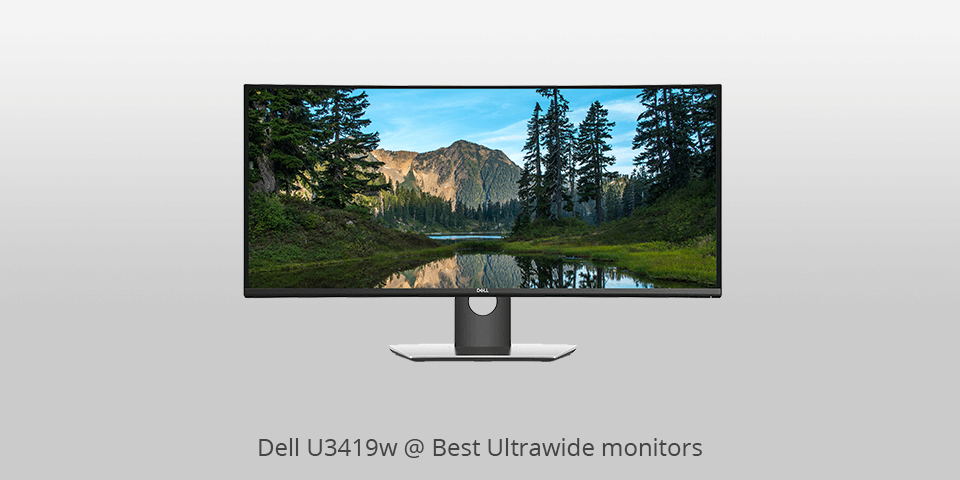
Screen size: 34-inch | Aspect ratio: 21:9 | Resolution: 3440x1440 | Brightness: 300 cd/m2 | Refresh rate: 60 Hz | Response time: 5 ms | Viewing angle: 178/178 | Contrast ratio: 1000:1 | Color support: 99% sRGB
⊕ Offers Picture-In-Picture (PIP)
⊕ ComfortView support
⊕ Offers Picture-By-Picture (PBP)
⊖ Has a low refresh rate
Dell U3419w is another great ultrawide curved monitor that, like all the monitors from the UltraSharp line, has a nice design. It features a cure radius of 1900r and WQHD 3440 x 1440 native resolution.
Also, it boasts a nice slim frame in the outside part which makes the display look very smooth and a good monitor for Mac. This monitor has passed the TUV2 certification and features a flicker-free screen with the ComfortView technology that reduces harmful blue light. It provides a minimum load on your eyesight, even if you are viewing something for a long time.
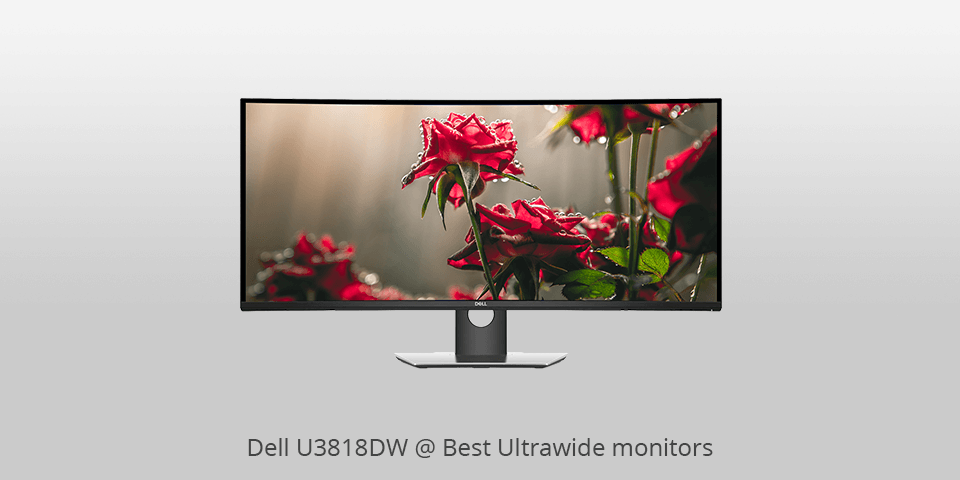
Screen size: 38-inch | Aspect ratio: 24:10 | Resolution: 3840×1600 | Brightness: 350 cd/m2 | Refresh rate: 60 Hz | Response time: 5 ms | Viewing angle: 178/178| Contrast ratio: 1000:1 | Color support: 99% sRGB
⊕ You can work from two different desktops
⊕ ComfortView support
⊖ Doesn’t support the AMD FreeSync technology
With this wide monitor, you can view and edit content from two different desktops. This is achieved by the KVM feature (keyboard, video and mouse).
This monitor has been TUV certified and has a flicker-free screen with the ComfortView feature. With this feature, harmful blue light gets filtered in order not to harm your eyes.
This monitor has a large 37.5-inch curved screen and frameless Infinity. The edge creates an almost complete field of view that provides a pretty even visual focus that minimizes eye movement on the screen.
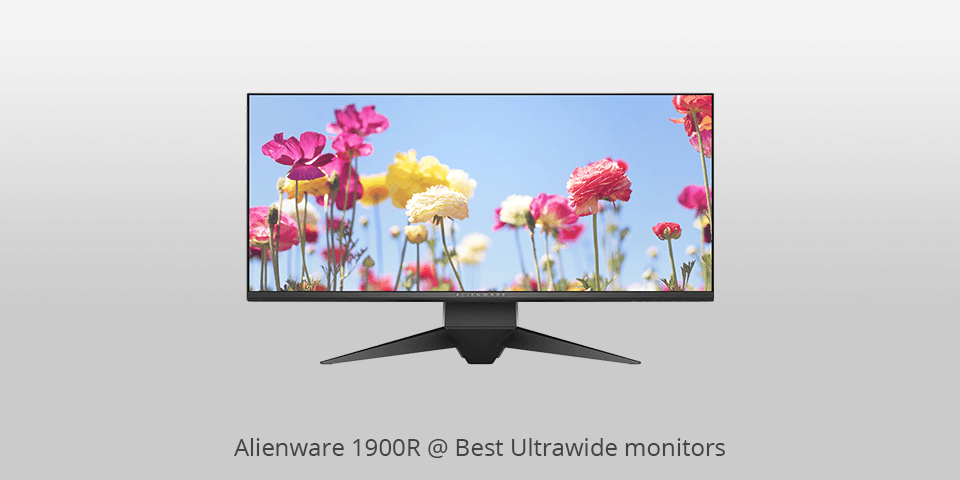
Screen size: 34.1-inch | Aspect ratio: 21:9 | Resolution: 3440 x 1440 | Brightness: 300 cd/m2 | Refresh rate: 120 Hz | Response time: 4 ms | Viewing angle: 178/178 | Contrast ratio: 1000:1 | Color support: 99% sRGB
⊕ Supports the G-Sync technology
⊕ Top image quality
⊖ Weights a lot
This display has a resolution of A 3440 X 1440 WQHD that provides a precise, clear image with 3.68 million pixels, which is 1.77 times more detailed than a Full HD display offers. In this way, it is the best ultrawide QHD monitor to help you see everything sharply.
Each drop of water or blade of grass will be perfectly visible, and the color will be deeper than it used to be before. Due to fact that this is a NVIDIA G-SYNC monitor, you will be able to see frames only when the monitor is ready to show them. It means that the frames of the screen load very fast.
| Image | Name | Features | |
|---|---|---|---|
 |
Samsung CJ791
OUR CHOICE |
CHECK PRICE → | |
 |
Alienware AW3420DW
FOR GAMING |
CHECK PRICE → | |
 |
LG 34WL600BOB
BUDGET |
CHECK PRICE → |
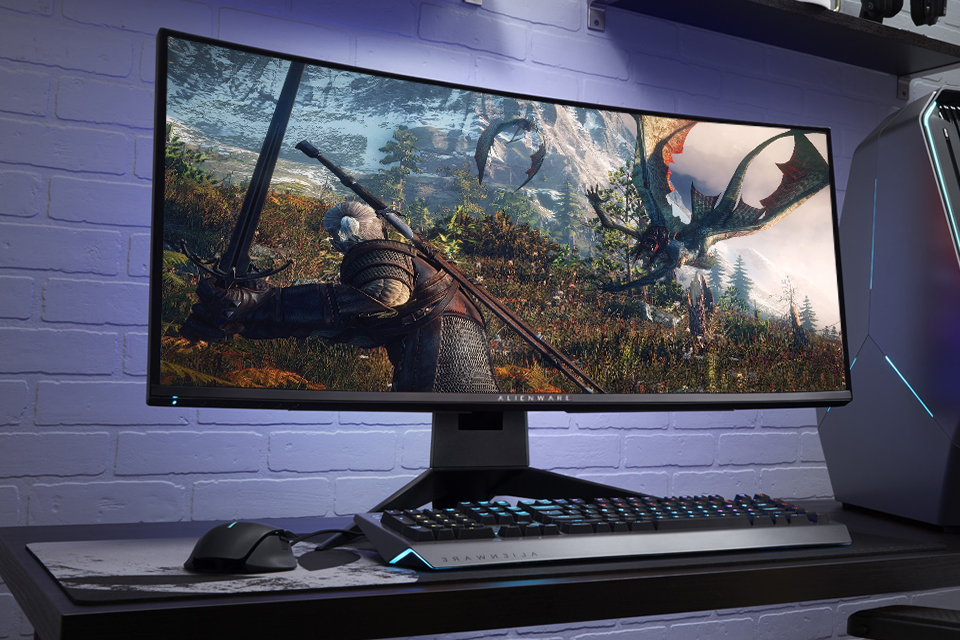
Resolution is a value that determines how sharp the image will be. Simply put, the higher the resolution, the more pixels there will be on the screen. However, before choosing the best 4K ultrawide monitor, you need to understand that after using 1440p and 2K monitors, it might be difficult to spot the difference in the quality of the image.
Previously, when you needed more screen place, you had to get one or two additional monitors or use a TV as PC monitor. Today, you just can buy one wide screen monitor and you're good to go. The regular size of such monitors is 34 inches, but some manufacturers have taken it even further.
IPS (in-plane switch) monitors provide richer blacks and sharper colors than the majority of LED or LCD monitors. This makes them suitable for editing photos, working with graphics and gaming. Also, such monitors have wider viewing angles, so that the image looks amazing even if you aren’t right in front of it.
LED (light-emitting diode) monitors offer great image quality. They provide more vivid images and need less energy than standard LCD monitors, which makes them ideal monitors for video editing. Also, they usually have slimmer designs. Monitors in this group are still LCDs, however, they have improved LED backlighting.
LCD (liquid-crystal display) monitors offer high-quality performance and, as a rule, are not expensive. They use liquid crystals to convey what you can see on the screen and are usually illuminated by CCFL (cold cathode fluorescent lamps).
Touchscreen monitors are suitable for home and multi-use. You can view pictures there, play touch-based games and tap tiles to use applications. If you want to get such a monitor, choose the one that has glass from edge-to-edge that provides for easy movement and a stand that you can adjust. In this way, you will be able to easily switch from work to films and games.
Several years ago, ultrawide monitors were very expensive. Now such monitors have the same price as standard pixel-for-pixel monitors, so you can easily find a decent monitor under 250 dollars. Usually, the cheaper the monitor is, the fewer pixels it has. Respectively, the more expensive a monitor is, the better resolution and image it will have.
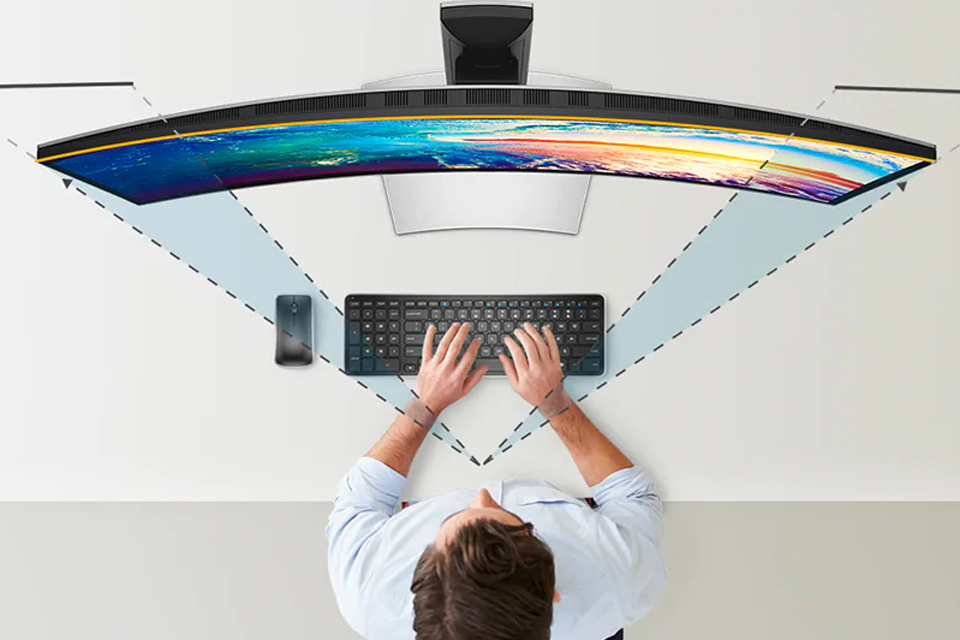
Working
A lot of people who work on computers say that using an ultrawide monitor or a few standard ones makes the working process faster and productivity – better. A 38-inch monitor is a good option in this case.
Playing games
For those who love playing, ultra wide gaming monitors have an advantage – the absence of frames. However, not everyone might like it. In some games, such as League of Legends, it’s important to have a large field of view. Such monitors will give you a competitive advantage.
Watching Films
If you enjoy watching films at home, an ultra wide Thunderbolt-equipped monitor is the best option for you as it will provide an awesome cinema experience and fast media transfer. Due to the widescreen ratio, black bars at the top and bottom of your screen aren’t necessary. Obviously, you can also watch films on the Internet, a DVD or your NAS storage drive.
Don’t buy a monitor unless you are absolutely sure that the graphics card of your computer can take it. For an ultrawide monitor, you will need one and a half times more graphics power on your computer. If you are going to play games, it should be even more.
Among multiple brands of desktop monitors, the most popular and qualitative are ASUS, ACER, LG and DELL. Samsung monitors occupy the second place in the rating.
Ideally, if you want to have two monitors, they should be the same ones. They need to have the same size, resolution. However, it’s not always the best option. If you use one wide monitor with a high resolution, you will have a great advantage of the horizontally enlarged screen.
Such monitors provide a large field of view and a desktop surface in games thatn a 19-inch monitor. This makes them more suitable for multitasking. On the other hand, high resolution guarantees a more powerful graphics processor.
Common sizes for ultrawide monitors range from 29 inches to 49 inches, with popular sizes being 34 inches and 35 inches. The most common aspect ratio for ultrawide monitors is 21:9, providing a wider and more immersive viewing experience.
You need to check the specifications of your graphics card and the maximum supported resolution. Ensure that the graphics card has the necessary display outputs (such as HDMI, DisplayPort, or Thunderbolt) compatible with the monitor's connectivity options (e.g., HDMI 2.0, DisplayPort 1.4) and supports the monitor's resolution and refresh rate requirements.
While ultrawide monitors offer an immersive viewing experience, they may have some drawbacks. One limitation is that not all applications and games are optimized for the ultrawide aspect ratio, which can result in black bars or stretched images.
Additionally, the larger size of ultrawide monitors may require more desk space and may not be suitable for compact or crowded workspaces.

 Rating
Rating